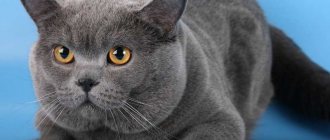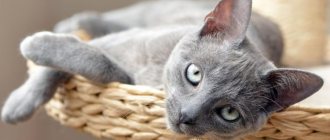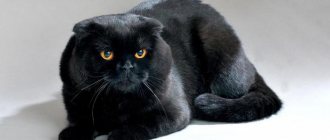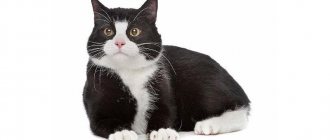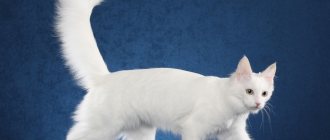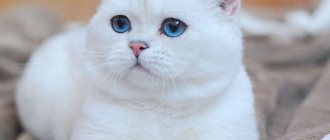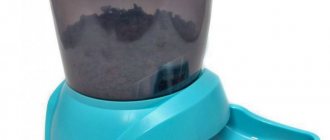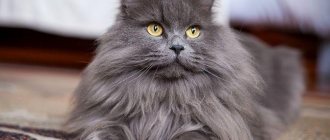Royalty can exist not only in human society, but also in the cat world. This postulate does not require proof, just look at Russian blue cat. She exudes aristocracy, slight arrogance and elusive grandeur. A barely perceptible half-smile and a deep gaze make you think that in front of you is a creature much smarter and wiser than just a cat.
And even in appearance, the Russian Blue cat breed is distinguished by a high quality mark. Not all cat women can boast of model appearance. The beauty and chic of a shiny fur coat is emphasized by a bluish-blue tint, which, from a human point of view, has always been considered elite in the animal community.
History of the origin of the Russian Blue breed
global $ads_google;
//data-ad-slot=”2475549904″ $ads_google = empty($ads_google) ? false : true; ?> if ($ads_google == false) {?> $ads_google = true; ?> } ?> When an unusual cat with bluish fur first appeared on Earth, history is silent. The first mentions of it date back to the 19th century. Rumor has it that English sailors, during their voyage through Arkhangelsk, found an extremely beautiful cat of an unknown breed on the Russian shores. She was given the nickname “Arkhangelskaya”. It was this cat that was brought to England, where in 1871 she took part in an exhibition in London.
Then the Russian Blue was given another nickname - “wild gray rabbit”. The reason for this comparison was not only the gray skin, but also the behavior of the Arkhangelsk emigrant. She behaved wildly and nervously, afraid of loud sounds and human company. Subsequently, when breeders focused on improving the breed, this drawback was reduced to almost nothing. Now Russian Blue cat kittens are born with a stable nervous system and are not afraid of noise.
The history of work to improve the gene pool of the breed began already in the twentieth century. The first such attempts date back to 1940. By 1965, breeders had made significant progress. To consolidate the initial characteristics and improve them, individuals were crossed with cats of the Scandinavian and Siamese breeds. But later they refused to breed with Siamese. The standard of the Russian Blue cat was finally formed in 1966.
These pets were recognized by all official felinological organizations. Since then, for decades, cats of the Russian Blue breed have been winning not only high awards at prestigious competitions, but the hearts of lovers of four-legged furry animals all over the world.
Turkish Angora
Gorgeous appearance
National treasure of Turkey. No, this is not a joke. The breed was recognized as such in 1930. Despite its unusual appearance, being the pride of the country, the Turkish Angora has long been considered an aboriginal cat; the WCF did not recognize the breed. Only in the 70s of the last century was justice achieved and the Turkish Angora was finally recognized. Today, the breed is recognized by all felinological organizations.
In the 20th century, only white cats were officially recognized. Nowadays, other colors are also acceptable. Moreover, completely white, blue-eyed cats have not been exported from Turkey for a long time, but animals with a different color are welcome, as many as you like.
Despite their luxurious appearance, Angoras are characteristic companions. Representatives of the breed are famous for their willfulness and independence. Communication with the owner is necessary, but is not the meaning of life for this breed. And the lack of the ability to climb and jump to heights leads to the fact that the cat begins to waste away. Angoras are very active animals; they love to jump, run and sit at heights. The best entertainment is hunting for a toy mouse. By the way, representatives of the breed will not refuse a live mouse.
Description of the Russian Blue cat
Body
Strong thin bones, elongated body parameters and well-developed muscles provide the Russian Blue with a flexible and graceful body. The long neck is hidden by fur, which creates the effect of its shortening.
Tail
This part of the body in animals is long, but always proportional to the body. Starting from a wide base, the tail gradually tapers to a sharp tip. If a kitten is born with creases in the tail, then this is considered a defect in the breed.
Limbs
The Russian Blue cat has limbs that are as elongated as the rest of the body. The soft, small paw pads are almost always round in shape. Their color can be pink or light purple. According to the breed standard, the forelimbs have five toes, the hind limbs only four.
Head
The wedge-shaped head with smooth outlines is of medium size. The cats' muzzle is blunt, without a break. If you look in profile, the head has elongated, flat features. An elongated forehead without a stop turns into a straight nose of a gray-blue hue. The chin of cats of this breed is medium in size, set perpendicular to the nose. The whisker pads are not clearly visible.
Ears
At the base, the ears are quite wide and gradually taper towards the tips. However, the tops of the ears are not rounded, but shaped like a corner. The ears are set wide apart. A distinctive feature of cats is their thin skin - upon close examination, it is almost translucent, despite the slight pubescence on the outer and inner sides of the ears.
Eyes
The wide-set eyes of Russian Blues are medium to large in size and almond-shaped, with a bright green iris. This is a distinctive and at the same time attractive feature of the breed. However, it is worth knowing that kittens are born with yellow eyes and only by the age of three months do they acquire the color according to the breed standard.
global $ads_google; //data-ad-slot=”2475549904″ $ads_google = empty($ads_google) ? false : true; ?> if ($ads_google == false) {?> $ads_google = true; ?> } ?>
Wool
The Russian Blue breed of cats is distinguished by short and very fine hair, which is somewhat distant from the surface of the body. Despite this quality, the fur coat of all representatives of the breed is thick and dense. This is partly due to the thick undercoat, which is equal in length to the guard hair. Touching the soft plush wool leaves a very pleasant feeling.
The color of a cat's coat is one of the main characteristics in the breed standard. Only individuals with blue hair are included in the purebred breed.
This shade is obtained due to the special structure of the guard hairs. Light hitting the wool is refracted and creates a blue effect. Kittens born with other coat colors, even if other criteria are met, are discarded and not allowed for breeding, so as not to spoil the appearance.
A purebred Russian Blue cat cannot have long hair. The long-haired variation of the breed is considered to be the Nibelung.
The breed is not considered hypoallergenic, but the level of allergies to them is quite low.
Dimensions and weight of the Russian Blue cat
In general, the body size of cats is average, this affects the weight of the pets.
A sexually mature Russian Blue cat weighs on average from 3.5 to 6 kg, females are slightly lighter than 2.5-5 kg and, after six months, gain weight more slowly. Table of approximate weight by month
| Age | Female | Male |
| newborn | 65-145 gr | 70-150 gr |
| 1 month | 260-620 gr | 540-750 gr |
| 2 months | 460-910 g | 950-1500 gr |
| 3 months | 1-1.45 kg | 1.4-2.5 kg |
| 4 months | 1.6-2.5 kg | 1.65-3.7 kg |
| 5 months | 2.1-2.9 kg | 2-4.1 kg |
| 6 months | 2.2-3.5 kg | 2.3-4.85 kg |
| 8 months | 2.4-4.1 kg | 2.6-5.2 kg |
| 10 months | 2.5-4.2 kg | 2.8-5.4 kg |
| 1 year | 2.55-4.4 kg | 3.1-5.6 kg |
| 2 years | 2.6-4.7 kg | 3.3-6.1 kg |
Castrated and sterilized animals gain weight more actively and, as a result, can weigh 1.5 times more than non-operated pets.
The size and weight of kittens depends on many factors, such as the quality and frequency of feeding, active lifestyle, gender, and genetic characteristics.
Do not forget to control the weight of your animal, first of all, its health depends on it!
White Persian cats
This is one of the most ancient breeds, it appeared in the 16th century. Cats are not the largest, medium-sized, and have thick, long and fluffy hair. By nature they are affectionate, peaceful and friendly, preferring tranquility and a more passive lifestyle, although they also like to play. They treat their owners with special reverence; they become very attached to people, so separation is simply unbearable for them. Persian cats are incredibly peaceful and will thrive in any environment.
The popularity of this breed among European aristocrats was instilled by Queen Victoria, who had more than a dozen of these cats. Now anyone can have such a pet.
White Persian cat
Characteristics of Russian Blues
Friendly and accommodating beauties are always welcome friends in the house. They feel good both in the company of a single person and in large families with children. In the latter case, the Russian Blue cat treats all members of the family favorably, but in the first place she has the owner, who cares about her the most.
global $ads_google; //data-ad-slot=”2475549904″ $ads_google = empty($ads_google) ? false : true; ?> if ($ads_google == false) {?> $ads_google = true; ?> } ?>
Cute Russian blue kittens have been showing their devotion and love since childhood. This quality of character remains with them into adulthood. The extraordinary green-eyed and blue cats have long been recognized for their ability to heal people. In case of illness, they always come to a person, giving him their warmth and healing energy.
Blue-haired cats lead a calm and measured lifestyle. However, their character cannot be called phlegmatic. They prefer moderate activity, which is expressed in the form of outdoor games with someone at home. The descendants of Arkhangelsk cats exhibit the habits and dexterity of hunters. Therefore, there are rarely mice in the house where they live.
Cats get along well with older children. They are tolerant of a small child if he does not cause them anxiety or excessive childish attention. Pets prefer a quiet atmosphere without loud screams. Therefore, frequent noisy parties and crowded holidays are not for them. Russian Blue cats are somewhat wary of strangers in the house. When guests arrive, they try to retire and wait out the visit in peace.
Naturally independent cats of the Russian breed easily tolerate loneliness. They do not get bored or depressed during periods of their owner's absence. But cats don’t tolerate moving and drastic changes in life very well. Stability and familiar surroundings are more preferable for them.
If there are other animals living in the house, then the cat is quite tolerant of such a neighborhood. The main thing is that she does not experience oppression from stronger pets, including cats of other breeds.
Snow-shoe
One shoe for all the shoes
Snow-white slipper, bred as a result of mating a Siamese cat and an American Shorthair. A distinctive feature of the snowshu is an inverted “tick” on its face, “slippers” on its front legs and huge blue eyes.
Representatives of the breed have a very specific disposition. Most cats are affectionate and sociable, but there are “alternatively gifted” individuals. Woe to anyone who owns such a cat. These individuals are aggressive, have a loud voice, and scream with or without reason. For the most part, snowshoes are silent people, attached to people. Some of our “alternatively gifted” brothers, on the contrary, love solitude and prefer to solve problems with a loud cry coupled with hitting the irritant with a clawed paw.
Care and maintenance of the Russian Blue cat breed
The rich coat of these domestic cats does not require very frequent brushing and grooming. It is enough to carry out this procedure once or twice a week. Russian Blue cats are clean animals and can maintain their beauty on their own, you just need to help them in this.
Cats are reluctant to bathe, which is another reason why you shouldn’t give them a shower too often. Wash pets only when absolutely necessary, using special products for this.
It is important to monitor the diet of blue-haired cats. Firstly, it must be low-calorie and balanced in nutrients and biologically active substances, as well as vitamins. And, secondly, feeding should be three times a day and highly desirable at the same time. Compliance with these rules will prevent excess weight gain, to which these cats are prone.
What to feed a one-month-old Russian Blue kitten
Veterinarians often do not recommend giving them milk, as this product can cause digestive upset. For older Russian cat kittens and adult cats of this breed, ready-made dry and canned food will be the most optimal. It guarantees that animals will not develop food allergies to which they are predisposed.
Otherwise, caring for kittens is not a problem. They are easy to educate and train; they can easily get used to the tray and scratching post.
Ragdoll
These cats are large (the third largest in the world) and have unparalleled thick and long hair. They differ from others in their passivity and relaxed muscle tone. Their character is quite pleasant, they are friendly, good-natured and affectionate, they are also very smart and incredibly loyal. They can also be considered excellent companions for other pets and children, because they completely lack aggression. The ideal living environment for this breed is peace and quiet, they cannot tolerate noise, but under no circumstances should they be left alone. They also differ in their slow development.
Buy a Russian blue kitten
global $ads_google;
//data-ad-slot=”2475549904″ $ads_google = empty($ads_google) ? false : true; ?> if ($ads_google == false) {?> $ads_google = true; ?> } ?> At the moment, everyone who wants to buy a Russian Blue kitten from a cattery can do so in Russia, Belarus, Ukraine and other countries. It is only important to choose healthy babies no younger than three months of age. In this case, they will grow into healthy, strong and beautiful cats, fully vaccinated and meeting the breed standard.
The price of a Russian blue cat ranges from 8,000 to 40,000 rubles
.
The cost depends on many factors, such as:
- Parents title
- Eliteness of the nursery
- Territoriality
- Full compliance with the standard
- Much more
What to name a Russian blue kitten
And now, a little bundle of happiness has appeared in your home.
You have already purchased toys, a toilet, a house for him and stocked up on food. But they still couldn’t figure out what name to give the kitten. Russian blue cats have nicknames associated with their color or eye color, as well as their history of origin and character traits. Nickname table
| Girl | Boy | ||
| Masya Blanca Sonya Fairy Rusya Taira Kusya Izya Veta Yesya Runa Tuchka Greya Roxy Lesya | Tensi Haze Tsiana Ilya Stella Sofia Klyopa Grau Cleo Christy Zvezdochka Asta Grinya Basta Moska | Emerald Sirius Porter Freak Blue Pitty Quartz Fanya Zubastic Dodger Eraser Indie Chip Bucks Antey | Frank Lucky Harvey Gray Ivanhoe Ike Karay Citron Willie Bentley Cosmos Sirius Harrison Murchik Charlie |
Not included in the top ten
Among the breeds of blue-eyed cats, there are several more in which this trait appears only from time to time.
Ragdolls
Complaisant blue-eyed beauties, whom breeders bred specifically for large families with small children. They are quite phlegmatic, but allow themselves to be drawn into games, large, proportionally built, with medium-length hair and a thick undercoat. Despite the fact that the weight of this wonderful creature can reach 10 kilograms, it seems like a plush toy to children and will never offend them, even if they are careless.
This is interesting! Ragdoll will prefer to go where they can’t reach him, to hide, but will not show aggression. This breed is characterized by a quiet purr; they make almost no other sounds.
Russian white
A graceful beauty with a silky dense coat of medium length, a fragile physique, and a calm, balanced character. Along with blue, both amber and green eyes are allowed.
But blue-eyed kittens are in particular demand.
Javanese
The result of the work of breeders who crossed Abyssinian cats with Siamese. The result is remarkable: the grace of the Abyssinians with the independence of the Siamese and a huge variety of colors.
Only pure white Javanese and light representatives who inherited the color from the Siamese have blue eyes.
White sphinx
Sphinxes are winning more and more hearts. White sphinxes with pinkish skin have blue eyes - one of the signs of purebredness.
These cats require special care and attention; they are affectionate and calm only in their own home, when their owner is nearby.
Return to content
Diseases of Russian Blues
A huge advantage of this breed of beautiful cats is that they are not characterized by hereditary diseases. However, this does not exclude some health problems throughout life. The main difficulties in the life of Russian Blue cats can be caused by:
- obesity;
- diabetes mellitus;
- arthritis;
- heart disease;
- allergies;
- respiratory diseases.
With careful care and regular visits to the veterinarian for routine vaccinations, these problems in pets can be avoided. In this case, Russian Blue cats can live up to 20 years.
It is noteworthy that the life expectancy of cats of this unique breed has increased significantly over the past few decades. In the 80s of the last century it was only 7-10 years. Modern life expectancy rates have become significantly higher.
Conclusions about the breed of Russian blue cats
Royal pride, independence and the same stellar beauty distinguish the Russian Blue breed from all representatives of the family. Despite their Russian roots, extraordinary beauties have won the favor of residents of many countries. They are loved and revered as noble creatures in Europe, America, and Japan.
Being the favorites of princes and nobles, cats of the Russian breed have carried their greatness and exquisite beauty through the centuries. The color of the coat seems to reflect their “blue blood”, emphasizing their uniqueness and elegant chic.
global $ads_google; //data-ad-slot=”2475549904″ $ads_google = empty($ads_google) ? false : true; ?> if ($ads_google == false) {?> $ads_google = true; ?> } ?>
Mekong Bobtail
A very interesting breed
Beauty comes from Asia. Initially, Mekong Bobtails were considered “rejected” Siamese cats. This is due to the unusual, short tail of Asian cats.
Despite its enormous popularity in its homeland, the breed was recognized by the WCF only in 1994. Russian breeders played a huge role in the recognition of Mekong Bobtails. They managed to prove that these cats are distinguished from Siamese not only by their short tail. Animals have completely different body types.
Representatives of the breed, for the most part, have rich blue eyes, a mischievous character and affection for the owner.
